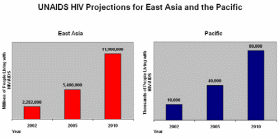HIV and People Who Use Drugs: Cases of Infection Caused by Injection Drug Use Report
The existing condition of the epidemic in a certain region can be termed as low-level, concentrated, or generalized depending on the prevalence levels of the virus in the specified demographic (John, 2001 p. 20-45). Cases of HIV can also be categorized according to their ways of transmission. According to the United Nations joint effort on AIDS (UNAIDS) sub-Saharan Africa has 26 million living with the virus. This translates to 70 percent of the total cases of HIV/AIDS (John, 2001 p. 20-45). The main mode of transmission is through heterosexual relations. In Asian countries such as China, Malaysia, Cambodia, Korea, Indonesia, Philippines, Thailand, Vietnam among others, and North Africa the prevalent mode of transmission is through unsafe drug injections while commercial sex work comes in second. In European and the Middle East countries as well as the southern part of Latin America sharing of needles accounts for 30-90 percent of infections n the regions (United States Congress, 1998 p.24-50).
The UN refugee group on HIV/AIDS prevention and care among IDU in developing and transitional countries was 2001 formed to keep the UNAIDS and other related sponsors updated on all developments on HIV infections among IDU in developing and transitional countries. The organization also seeks to verify information on international HIV epidemiology along with prevention and care measures to be adopted among IDU (). Accurate information on the number of IDU globally is not available regardless of the need for this information in planning for harm reduction (needle distribution or treatment) and distribution of the antiretroviral drugs among the IDU. This report seeks to highlight the research done on HIV and people who use drugs that expose them to possible infection by the virus.
The Situation on HIV and Injectable Drug Users
At the United Nations General Assembly Special Session in 2001, all countries pledged to join the fight against HIV/AIDS. Researchers have been working all over the world to contain the HIV virus and they have had a rough time trying to combat HIV because of its highly infectious nature. Studies on the human defense system and the virus have led to the discovery of current antiretroviral drugs aimed at suppressing the virus to ensure that it does not overpower the body’s defense system (Jacquelyn & Peter 1995 p.40). Notable progress has been made in fighting HIV/AIDS globally. However, the epidemic remains a development challenge in the whole world since it is a threat to human resources and thus bound to affect the development rate globally.
Based on statistics from the Population Reference Bureau, the number of infected people globally adds up to 36 million and the number could be on the rise if adequate measures are not taken soon enough (Jacquelyn & Peter 1995 p.46). The continent of Asia has the largest number of people; it holds almost half of the world’s population. It, therefore, plays a major role in depicting the future trends of the HIV/AIDS pandemic. If the numbers of infections increase in India, China, and Indonesia to the current levels in Cambodia and Thailand then the world will risk doubling the number of infected persons (Jacquelyn & Peter 1995 p.49). Such a phenomenon can impact negatively on the health systems and economies because of the large numbers that the hospitals will have to deal with and the amount of money the government will have to reallocate to the health sector to serve the rising need for health care.
East Asia and the Pacific (EAP) countries are part of the Asian continent. Population reference bureau says that this region (EAP) has a population of 2 billion people with 2.3 million among them infected with HIV/AIDS (United States Congress, 1998 p.24-56). Each country in East Asia and the pacific have different infection rates. In countries like Myanmar, Thailand, and Cambodia HIV/AIDS has been there for a long time and has spread quickly while countries like China and Vietnam have recently started to experience the epidemic. In most of these countries, the epidemic is spread through having unprotected sex especially among commercial sex workers and drug users who share needles and syringes as well as men who have unprotected sex with men. Most of the infected people come from these groups and their interaction with the others takes the infections to the general population. In China, the transmission of HIV is high through sexual intercourse with partners who inject themselves with drugs (Borowitz 2004 p.102).

Figure 1. UNAIDS HIV Projections for East Asia and the Pacific
From the above projection from UNAIDS the number of people living with AIDS is likely to double
Order this paper